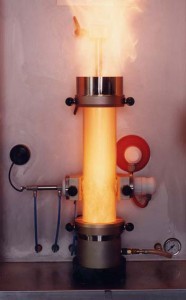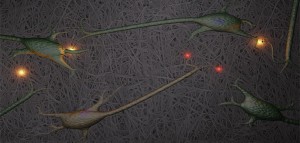I was introduced, kicking and screaming all the way, to Gaston Bachelard‘s book, The Poetics of Space in one of my first courses at university. It was, as I remember it now, a kind of meditation on structures such as houses, shells, nests, etc. and the relationship between those structures and our memories and consciousness. From the Poetics of Space, Beacon Books, 1958 (1970 printing),
A house constitutes a body of images that give mankind proofs or illusions of stability. We are constantly re-imagining its reality: to distinguish all these images would be to describe the soul of the house; it would mean developing a veritable psychology of the house.
To bring order into these images, I believe that we should consider two principal connecting themes: 1) A house is imagined as a vertical being. It rises upward. It differentiates itself in terms of verticality. It is one of the appeals to our consciousness of verticality. 2) A house is imagined as a concentrated being. It appeals to our consciousness of centrality.
The Rennie Collection (where the Moppett show is being held until April 21, 2012) is housed in one of Vancouver’s historically important buildings, the Wing Sang Building. The building houses both the Rennie Collection of art (gallery/museum) and Bob Rennie‘s businesses (real estate marketing and real estate sales). The consequence of co-locating two of Rennie’s primary pursuits (art and real estate) is that the verticality of the building or more specifically, the gallery/museum is emphasized since the gallery occupies only 1/2 or less of a building that has been split along its vertical axis.
Damian Moppett, the Vancouver-based artist whose work is being shown, has a giant mobile (referencing Alexander Calder) hanging from the highest ceiling on the building’s top floor (each of the three rooms on that floor enjoys a different ceiling height) further emphasizing the verticality.
The giant mobile, titled ‘Breaking the fall‘ (I hope I remembered that title correctly; ETA Mar.23.12 The title, according to Aaron Carpenter’s article for New York Arts Magazine is ‘Broken Fall‘), has a flaw. One of the pieces has fallen onto the floor and the mobile no longer balances perfectly. One of the themes in Moppett’s work is that art is not perfection, it takes work and he often makes that work and/or flaws visible. The pictures (cartoons/doodles) on the main floor of the gallery show the pencil lines and other marks that would usually be removed from a finished piece.
Our guide, Karen, offered a set of references for the cartoons/doodles. A student at the University of British Columbia (visual arts dept.?), she mentioned a few names that escape me at this point. For me, they were reminiscent of images from Pan’s Labyrinth (a 2006 film directed by Guillermo del Toro),

I found this image somewhere (not sure exactly where). It's either a still from or a poster for Pan's Labyrinth.
Moppett’s images are more benign but both sets of images (Moppett’s and del Toro’s) could be described as surreal.
Pottery (found on the gallery’s 2nd floor and integrated in sculptures), a form that Moppett has taken up recently, extends the notion of imperfection. These piece are not the kind of thing one would usually find in a fine art gallery by virtue of the fact that they are, both, beginner’s pieces and pottery, i.e., craft work.
The film, which is found in the basement, is yet another commentary on imperfection. Photographed on Salt Spring Island, the film documents Moppett in a forest as he builds a trap. It mimics the shape of a sculpture (which you’ll see on the 2nd floor gallery), is flimsy, and will never function properly.
Karen informed us the film is a commentary on Canadian artists and landscape art (think ‘Group of Seven’, Emily Carr, Tom Thomson, etc.), which serves to create and extend the myth of the pristine Canadian wilderness while it is exploited. A kind of chimera if you will, artists creating a utopia that doesn’t exist anywhere except in the imagination while reality presents an opposing perspective.
I thought the film was the least successful of the pieces and I’m not sure why I think that. It seems to me that it has something to do with physicality and one’s sense of Moppett’s hand in all of his pieces.The trap that Moppett constructs is not accessible to us and so the physicality which is present in his other work disappears. It also seemed, in an odd way, that Moppett became prey to the same impulse to idealize nature that he was critiquing. The images of the forest are gorgeous and subsume what I think he was trying to portray. Maybe one of these days, he or a curator could include the trap as part of the installation rather than showing only the film.
While Moppett comments on imperfection, it should be noted that he has mastered the crafts of drawing and painting, unusual in artists trained in the 1990s (and later) many of whom have never mastered (or, if my information is correct, learned) those skills/crafts, historically associated with art. That’s something else you’ll find in Moppett’s work, historical references to art.
For anyone who might be concerned that you need an art history degree to look at the art; good work doesn’t punish you for your ignorance or, on the other hand, render itself cliché if you’re knowledgeable because it evokes universal feelings, quandaries, struggles and more. Shakespeare’s work is appreciated around the world in many languages because its power is not in the English language itself but in what his language evokes; although you might need a little help understanding things at first since daily life (to which he refers) has changed mightily since Shakespeare’s time. [I changed preceding sentence, the original is appended to the end of this posting.]
I particularly appreciated the correspondences between the pieces. Shapes, colours, themes, and characters were seen in multiple drawings, paintings, and sculptures. For example, seeing a caryatid in a painting in one room, coming across the caryatid as a sculpture in another room, having the guide mention the role caryatids play in classic art and then mixing in my own references to caryatids (admittedly few) suggested a set of relationships that were new to me.
Before I go on, here’s a caryatid and a description from Wikipedia,
A caryatid (Greek: Καρυάτις, plural: Καρυάτιδες) is a sculpted female figure serving as an architectural support taking the place of a column or a pillar supporting an entablature on her head.
The relationships that were new to me, were the ceilings. The first caryatid (painting) was on the 2nd floor in the room with the tallest ceiling, the second caryatid (sculpture) was in the room with the shortest ceiling. The movement from two dimensions in a room with a soaring ceiling to three dimensions in a room where the ceiling seems to press down on a figure that in classical art is an architectural feature designed to hold things up evoked a set of rich relationships.
The building which I’ve always perceived as quite vertical became even more so. The tour took place on International Women’s Day and so the image of women holding things up took on a particular resonance, especially since one of the caryatids was in a building that had housed four of the owner’s wives. The reference to a classical Greek architectural feature in an historically important building in Vancouver’s Chinatown provided an interesting juxtaposition.
Each person brings their own references and experiences to the show or any show for that matter. I think what distinguishes Moppett’s show at the Rennie Collection is a kind of openness. You can see the references, you can see the imperfections, you can see the artmaking process and those factors allow for a different kind of engagement.
Moppett is the first local artist (I understand he is represented by Catriona Jeffries) to be featured at the Rennie Collection. There’s not a lot about Moppett online (in common with many artists he prefer to leave the writing to someone else; ETA March 23, 2012: Ooops, I found more. You can find links to other reviews and commentaries of Moppett’s work here in the Rennnie Collection’s Mar.14.12 news listings) but I did find this about a 2007 show in Paris (from the French language article on Artnews.org),
Pour cette exposition Damian Moppett présente un ensemble de nouvelles oeuvres comprenant neuf peintures et deux sculptures. Plusieurs constantes marquent la pratique de Moppett comme artiste. D’abord, un électrique et personnel catalogue de références : à des œuvres et à des artistes particuliers du passé et du présent (Calder, Brancusi, Rodin, Rauschenberg, Fischli and Weiss..); à des œuvres dans son atelier ; au phénomène de la culture populaire et à des pratiques culturelles, en marges du monde de l’art. La première étape de Moppett est de recueillir et de documenter ses références, sources en fonction d’un ensemble de critères subjectifs qu’il applique toutefois de façon systématique ; les documents assemblés (qui seront ou non exposés) forment alors une archive extensible de références.
Rough translation: His show included nine paintings and two sculptures. He referenced a number of artists in his work, as well as, popular culture and artmaking practices on the fringes of the art world.
As for the ‘consciousness of centrality’ mentioned in the Bachelard quote, I’m going to take liberties and apply that notion to Moppett’s work. In Bachelard’s description of a house there’s an interplay between the basement and the attic and the consciousness and memories one brings to both places. In the Rennie Collection building, we toured the main floor, top floor (three rooms of varying ceiling heights), the basement where Moppett’s works were displayed and the roof where they were not.
One’s consciousness and memories are affected by ‘place’. By that token, the film meant to evoke Canada and landscape art is in the basement/Canadian subconsciousness and our notions of the pristine north. Had the film been shown elsewhere in the building, or in the world for that matter, another set of memories, subconscious or otherwise, would have been evoked.
The show ends in another month and you can signup for the tours here or you can book an appointment, which is done for groups of 10 or more.
On a completely other note: During the summer, the Royal BC (British Columbia) Museum will take over the space for its first show ever in Vancouver.
Here’s a little more about what they’ll be doing, from the March 9, 2012 Royal BC Museum news release,
Curious is the overall theme of four new and concurrent summer installations created by the Royal BC Museum: Intimate Glimpses, Artifact|Artifiction, Magic Lantern and Bottled Beauty [June 14 to September 3, 2012]. Each is built around unique items and stories from the 125-year-old provincial museum and archives, based in Victoria.
Intimate Glimpses
Emily Carr – the evolution of an artist
One of Canada’s most beloved artists, Emily Carr (1871-1945) was famous for her depictions of First Nations villages and monumental art, the forests and landscapes of British Columbia. This exhibition draws on the extensive collections of the Royal BC Museum and BC Archives to explore Carr’s youth and the early period before she became recognized. It includes more than 30 of Carr’s paintings, early sketches, and illustrated ‘funny books.’ A timeline places Carr’s art alongside national and international events with many photographs of the young artist and her family as well as displays of clothing, objects and artifacts from the same period. Letters, diaries and sketches reveal intimate glimpses of her private life, friendships and activities as a young woman. New research and findings are presented and some of the material in this exhibition will have never before been on public view.
Artifact|Artifiction
Test wits with our curators
Just for fun, visitors are invited to pick up a game card and play a mini-version of the Royal BC Museum’s annual gala game. Each of 14 items on display in this room will come with a curator’s statement – but is it Artifact? or Artifiction? All items are from the museum’s collection, but the tale told about each may be true or false. Visitors can practice as warm-up for
the entertaining fundraising evening held each October at the Royal BC Museum in Victoria. At that event, gala-goers can quiz curators and archivists before answers are revealed and prizes awarded. Those playing the game over the summer will get the satisfaction of their score and of learning a few new things about BC’s history.
Magic Lantern
British Columbia seen through glass
In a time before colour photography, black images on glass were hand-tinted and projected by a “magic lantern.” The 1850s to 1930s was the era of lantern slides and most were made to instruct or entertain audiences. A row of enlarged backlit slide images of people and places in BC, selected from thousands in the Royal BC Museum collection, will fill a hallway gallery near an original lantern slide projector. Images include strawberry pickers in Saanich, a hiker on Grouse Mountain and a giant Nuu-chah-nulth canoe on Nitinat Lake.
Bottled Beauty
Creatures from the collection
One hundred creatures the colour of pale peanut butter, pickled in jars then artfully uplit in a darkened room, have a strangely beautiful effect. A Western Fox Snake, Bell-headed Tailed Jelly and Great Basin Pocket Mouse are just three specimens from the Royal BC Museum’s “wet collection,” thousands of animals preserved in alcohol, some of them dating back to the 1800s. Specimens like these provide the museum’s natural history experts and researchers worldwide with information on climate change, species diversity, and wildlife and habitat conservation.
Unlike the usual shows, admission will be charged.
Editing change Mar.23.12, original sentence: Good work allows you to be ignorant or knowledgeable because it speaks to you or stimulates you.



